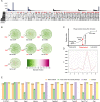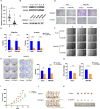Dynamic network biomarker C1QTNF1 regulates tumor formation at the tipping point of hepatocellular carcinoma
- PMID: 38498315
- PMCID: PMC11293248
- DOI: 10.17305/bb.2024.10103
Dynamic network biomarker C1QTNF1 regulates tumor formation at the tipping point of hepatocellular carcinoma
Abstract
Identifying the precise moment before the onset of hepatocellular carcinoma (HCC) remains a significant challenge in the medical field. The existing biomarkers fall short of pinpointing the critical point preceding HCC formation. This study aimed to determine the exact tipping point for the transition from cirrhosis to HCC, identify the core Dynamic Network Biomarker (DNB), and elucidate its regulatory effects on HCC. A spontaneous HCC mouse model was established to mimic HCC formation in patients with chronic hepatitis. Using the DNB method, C1q and tumor necrosis factor (TNF) related 1 (C1QTNF1) protein was identified as the key DNB at the crucial tipping time of spontaneous HCC development. Both in vitro and in vivo studies showed that C1QTNF1 could inhibit tumor growth. Overexpression of C1QTNF1 before the tipping point effectively prevented HCC occurrence. Patients with elevated C1QTNF1 expression demonstrated improved overall survival (OS) (P = 0.03) and disease-free survival (DFS) (P = 0.03). The diagnostic value of C1QTNF1 was comparable to that of alpha-fetoprotein (AFP) (area under the curve [AUC] = 0.84; sensitivity 85%; specificity 80%). Furthermore, our research indicated that platelet-expressed C1QTNF1 is involved in cancer-associated signaling pathways. Our findings introduce a novel perspective by highlighting C1QTNF1 as the pivotal biomarker at the tipping point of primary HCC formation using DNB. We propose C1QTNF1 as a prognostic biomarker for HCC, potentially influencing tumor development through a platelet-related cancer signaling pathway.
Conflict of interest statement
Conflicts of interest: Authors declare no conflicts of interest.
Figures






Similar articles
-
C1QTNF1-AS1 regulates the occurrence and development of hepatocellular carcinoma by regulating miR-221-3p/SOCS3.Hepatol Int. 2019 May;13(3):277-292. doi: 10.1007/s12072-019-09944-5. Epub 2019 May 8. Hepatol Int. 2019. PMID: 31069760
-
Potential of C1QTNF1-AS1 regulation in human hepatocellular carcinoma.Mol Cell Biochem. 2019 Oct;460(1-2):37-51. doi: 10.1007/s11010-019-03569-w. Epub 2019 Jun 6. Mol Cell Biochem. 2019. PMID: 31222560 Free PMC article.
-
Dynamic network biomarker indicates pulmonary metastasis at the tipping point of hepatocellular carcinoma.Nat Commun. 2018 Feb 14;9(1):678. doi: 10.1038/s41467-018-03024-2. Nat Commun. 2018. PMID: 29445139 Free PMC article.
-
A novel prognostic biomarker SPC24 up-regulated in hepatocellular carcinoma.Oncotarget. 2015 Dec 1;6(38):41383-97. doi: 10.18632/oncotarget.5510. Oncotarget. 2015. PMID: 26515591 Free PMC article.
-
TFAP4 Promotes Hepatocellular Carcinoma Invasion and Metastasis via Activating the PI3K/AKT Signaling Pathway.Dis Markers. 2019 Jun 10;2019:7129214. doi: 10.1155/2019/7129214. eCollection 2019. Dis Markers. 2019. PMID: 31281549 Free PMC article.
Cited by
-
Deciphering the oncogenic network: how C1QTNF1-AS1 modulates osteosarcoma through miR-34a-5p and glycolytic pathways.Front Oncol. 2025 Jan 9;14:1485605. doi: 10.3389/fonc.2024.1485605. eCollection 2024. Front Oncol. 2025. PMID: 39850812 Free PMC article.
References
-
- Sung H, Ferlay J, Siegel RL, Laversanne M, Soerjomataram I, Ahmedin Jemal DMV, et al. Global Cancer Statistics 2020: GLOBOCAN estimates of incidence and mortality worldwide for 36 cancers in 185 countries. CA Cancer J Clin. 2021;71(3):209–49. https://doi.org/10.3322/caac.21660. - PubMed
-
- European Association for the Study of the Liver. EASL clinical practice guidelines: management of hepatocellular carcinoma. J Hepatol. 2018;69(1):182–236. https://doi.org/10.1016/j.jhep.2018.03.019. - PubMed
-
- Llovet JM, De Baere T, Kulik L, Haber PK, Greten TF, Meyer T, Lencioni R, et al. Locoregional therapies in the era of molecular and immune treatments for hepatocellular carcinoma. Nat Rev Gastroenterol Hepatol. 2021;18(5):293–313. https://doi.org/10.1038/s41575-020-00395-0. - PubMed
-
- Vogel A, Meyer T, Sapisochin G, Salem R, Saborowski A, et al. Hepatocellular carcinoma. Lancet. 2022;400(10360):1345–62. https://doi.org/10.1016/S0140-6736(22)01200-4. - PubMed
-
- Rizzo A, Ricci AD, and Brandi G. Atezolizumab in advanced hepatocellular carcinoma: good things come to those who wait. Immunotherapy. 2021;13(8):637–44. https://doi.org/10.2217/imt-2021-0026. - PubMed

